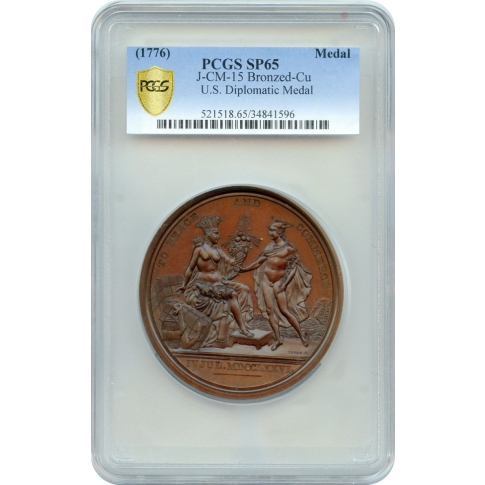1776 U.S. Diplomatic Medal, Bronzed-Cu PCGS SP65
Superb (1876) United States Diplomatic Medal
Restrike PCGS Specimen-65
Coin Highlights:
- Struck in Copper.
- Size: 68mm.
- Less than 100 Restrikes minted in 1876. Professionals estimate original mintage between 69 to 86 pieces.
- Graded and encapsulated by PCGS as Specimen-65 Brown (SP65BN).
- Population of only 4 coins, (1) SP55; (1) SP62; (1) SP64; the present SP65 specimen.
- One of the four Originals, graded as the SP55, brought $188,000 at auction in October 2015. It was certified by PCGS.
- That leaves only this coin as the remaining Specimen available for private hands!
- #73 in 100 Greatest American Tokens and Medals by Q. David Bowers.
- Missing from such important institutional holdings as the National Numismatic Collection at the Smithsonian Institution and the American Numismatic Society.
- This design is so significant that the Paris Mint reproduced 1,776 one (1) and two (2) ounce Proof gold commemoratives in 2013 featuring the design. Asset made have sold many of these already!
This is a Restrike one of the rarest and most important of all U.S. Medals - the 1792 United States Diplomatic Medal, of which just four (4) original specimens are known to exist. These Restrike medals were reissued in 1876 by Charles Barber and limited to less than 100, exactly one hundred years after it’s inception.
HISTORY
The then Secretary of State Thomas Jefferson conceived and helped design this medal as a gift to foreign diplomats "on their taking leave of us." The famous French sculptor and engraver Augustin Dupré created the die from which two gold and six bronze medals were struck.
In 1792, the gold medals were presented to two Ministers to the United States between 1779 and 1791. First, one was awarded to the Marquis de la Luzerne, French Minister to the United States from 1779 to 1784, and then the other in 1791 to the Count de Moustier, French Minister to the United States from 1787 to 1791. After that, however, this medal was no longer used as an official diplomatic gift. These two medals are untraced, almost certainly lost in the upheaval of the French Revolution.
Eighty years later, none of the original medals could be found, but Dupré's son still had his father's original lead proof. He loaned it to the U.S. Mint at Philadelphia where Charles E. Barber engraved new dies. The 1792 Diplomatic Medal was recreated in time for America's Centennial celebration in 1876."
One of just four original specimens known to exist, with it’s original ferrous loop still intact, appeared for sale at public auction in the fall of 2015 and brought $188,000 on a reserve price of $30,000 to $50,000 (see images below). Interestingly, since the end of the Civil War, collectors have had the opportunity to acquire a specimen of this rarity at public auction just six times, in 1863 (Colburn), 1882 (Bushnell), 1981 (Garrett), 1990 (NASCA), 2004 (Ford) and this one, 2015. The Bushnell/Garrett/Ford appearances are for the same specimen.
The obverse depicts an allegory of America, in her common guise as a Native American princess, holds a cornucopia or horn of plenty and gestures to bundles and a hogshead beside an anchor. Our princess is approached by Mercury, the god of science and commerce, and adorned in a flowing robe and holding his caduceus. In the lower right, a ship representing Atlantic commerce and interactions with Europe is in his background. The legend TO PEACE AND COMMERCE is appropriate to the scene; the date July 4, 1776 is rendered in Roman numerals in the exergue.
On the reverse, we find the first version of the Great Seal of the United States ever executed in medallic form, correctly showing the olive branch of peace at dexter (eagle's right) and the arrows of war at sinister (eagle's left, viewer's right). We also see the correct depiction showing the rays of light "breaking through a cloud," as specified in the official 1782 description of the Great Seal.
The eagle holds a banner inscribed with the national motto E PLURIBUS UNUM in his beak and an escutcheon or shield is displayed on his breast. A glory of 13 stars is atop the obverse, and the legend THE UNITED STATES OF AMERICA surrounds the arms at the periphery. These are Autograph Sketches for the Great Seal of the United States as created by Augustin Dupre (see below).
While other medals recall the earliest days of the American experiment, none are so rare as the Diplomatic Medal, and none were so central to America's foreign policy. As has been pointed out by historians and scholars, the cost of the original medals and dies represented more than one-eighth of the Secretary of State's entire budget for 1790-1791, showing that "the Diplomatic Medal was clearly of the highest importance to him." Only its rarity has kept it from the spotlight it deserves today.
| PCGS # | 521518 |
|---|---|
| Grading Service | NONE |
| Year of Issue | NONE |
| Grade | NONE |
| Denom Type | N/A |
| Mint Location | NONE |
| Designation | NONE |
| Circ/UnCirc | Not Specified |
| Strike Type | N/A |
| Holder Variety | J-CM-15 Bronzed-Cu |
| Grade Add On | NONE |
| Holder Type | N/A |



